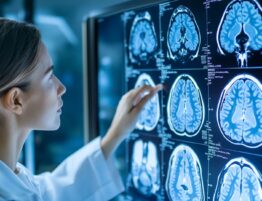Sciatica and pinched nerves cause sharp, radiating leg pain that can significantly disrupt your ability to work, sleep, and perform everyday activities. Sciatica refers to symptoms resulting from irritation of the sciatic nerve, often caused by a herniated disc or bone spur pressing against the nerve root. A pinched nerve occurs when surrounding tissue compresses any nerve in your body, including nerve roots in the spine.
Accurate diagnosis is essential because several conditions can mimic sciatica, including hip arthritis, vascular problems, or peripheral neuropathy. Without proper testing, you may receive treatment for the wrong condition, which can delay recovery and potentially worsen symptoms.
Neurologists rely on two specialized tests to pinpoint nerve dysfunction: electromyography (EMG) and nerve conduction studies (NCS). An EMG test involves inserting a fine needle electrode into specific muscles to record their electrical activity both at rest and during contraction, revealing whether muscles respond normally to nerve signals or show signs of denervation or disease.
NCS uses surface electrodes placed on your skin to stimulate nerves and measure how quickly and strongly signals travel through them. Together, these tests create a comprehensive map of nerve health, spanning from the spinal nerve roots to the peripheral nerves in your limbs. They detect subtle changes that MRI scans alone might miss, such as axonal loss or conduction blockages. Early EMG/NCS testing guides targeted therapy, helping you avoid unnecessary procedures.
What Is an EMG Test and How Does It Work
An EMG test evaluates the electrical activity in your muscles and the nerves controlling them. During the procedure, a neurologist inserts a thin, sterile needle electrode directly into selected muscles, typically testing five to ten muscles per limb. The needle records spontaneous electrical activity when your muscle is relaxed, then traces the response pattern when you gently contract the muscle.
Healthy muscle tissue remains electrically silent at rest. If the needle detects fibrillation potentials or sharp waves when you’re relaxed, this indicates denervation caused by nerve injury. During mild muscle contraction, motor unit potentials should appear in a normal pattern. Abnormal sizes, shapes, or recruitment patterns suggest neuropathy or muscle disease.
Key benefits include:
- Distinguishing nerve root compression from peripheral neuropathy or muscle disease
- Detecting early axonal damage before MRI changes appear
- Reaching 80-90% sensitivity for diagnosing radiculopathy
- Predicting recovery timeline and appropriate rehabilitation intensity
- Preventing misdiagnosis of conditions like ALS or polymyositis
The procedure takes 30 to 60 minutes. Most patients describe brief discomfort similar to a deep pinch when each needle is inserted. Risks are minimal, with minor bruising or infection occurring in less than 0.1% of cases.
Understanding Nerve Conduction Studies and Preparation
A nerve conduction study assesses how effectively your peripheral nerves transmit electrical signals, measuring both the speed and efficiency of this transmission. NCS is almost always performed in conjunction with EMG to provide doctors with a comprehensive picture of nerve and muscle function. The procedure helps diagnose peripheral neuropathy, carpal tunnel syndrome, sciatica, and various nerve injuries.
Preparation tips:
- Inform your doctor about previous nerve injuries, surgeries, and current medications
- Clean your skin without lotions or oils for better electrode contact
- Wear loose, comfortable clothes that allow easy access to arms and legs
- Limit caffeine to prevent jitteriness that interferes with readings
- Stay relaxed, as muscle tension can affect test accuracy
- Expect mild tingling sensations during nerve stimulation
- Plan 30 to 60 minutes for the complete testing
When combined with EMG, nerve conduction studies pinpoint the exact location, type, and severity of nerve dysfunction, whether caused by compression, injury, or disease.
Sciatica vs. Pinched Nerve: How EMG/NCS Clarifies the Cause
Sciatica and pinched nerves often produce similar symptoms, including radiating pain, numbness, tingling, and weakness. Distinguishing between these conditions is crucial for selecting the appropriate treatment. EMG and NCS explained serve as powerful diagnostic tools identifying both the source and severity of nerve dysfunction.
EMG measures electrical activity in your muscles, revealing whether nerves are irritated or damaged. NCS evaluates how efficiently electrical signals travel along specific nerves by measuring conduction speed and signal strength.
What testing reveals:
- Symptom mapping: Identifies which specific nerve roots or peripheral nerves are affected
- Signal speed measurement: Determines whether nerve impulses travel at normal speeds
- Muscle response patterns: Detects abnormal electrical activity indicating nerve compression
- Severity assessment: Determines whether the nerve is mildly irritated or severely compressed
- Precise localization: Pinpoints the exact anatomical location of nerve compression
- Differential diagnosis: Distinguishes sciatica from peripheral nerve entrapment or neuropathy
- Treatment planning: Guides decisions about physical therapy, medications, injections, or surgery
- Progress monitoring: Tracks whether your condition is improving over time
By combining EMG and NCS explained data with clinical symptoms and imaging results, doctors accurately diagnose the underlying cause of your leg pain, numbness, or weakness. This precision ensures targeted treatment, faster recovery, and reduced risk of long-term nerve damage.
Diagnosing Radiculopathy: When EMG/NCS Is Recommended
Radiculopathy occurs when the spinal nerve roots become compressed or inflamed, typically due to a disc herniation, foraminal stenosis, or a synovial cyst. Classic symptoms include sharp pain following specific patterns, sensory loss, muscle weakness, and reduced reflexes. L5 radiculopathy weakens your ability to lift your foot and extend your big toe, while S1 radiculopathy impairs your ability to push down with your foot and reduces your Achilles reflex.
EMG directly tests nerve root function by examining muscles supplied by specific nerve roots. The needle examination samples both limb muscles and paraspinal muscles along your spine to reveal characteristic denervation patterns. Finding abnormalities in the paraspinal muscles confirms that the problem originates at the nerve root rather than in the peripheral nerves.
When doctors recommend testing:
- Symptoms persist for more than six weeks despite conservative treatment
- Noticeable muscle weakness or atrophy is present
- MRI shows multiple levels of spinal degeneration
- You’re considering surgery and need objective severity data
- Your symptom pattern seems atypical
Timing matters because nerve damage can take time to appear on an EMG. Abnormalities typically appear two to three weeks after injury in limb muscles and seven to ten days in paraspinal muscles. Testing too early might miss these changes.
EMG/NCS sensitivity reaches 85% for diagnosing clinically significant radiculopathy. The tests quantify axonal loss, with mild denervation (less than 30% motor unit dropout) predicting good recovery and severe denervation (more than 70%) indicating likely permanent deficits.
Interpreting Results and Planning Treatment
EMG/NCS reports grade nerve abnormalities as mild, moderate, or severe based on fibrillation density, motor unit loss, and nerve conduction studies parameters.
Treatment pathways:
- Mild findings: Aggressive physical therapy combined with medications like gabapentin and specific exercises
- Moderate findings: Addition of targeted epidural steroid injections to reduce inflammation
- Severe or progressive findings: Surgical consultation within two weeks to prevent permanent nerve damage
Follow-up testing occurs at six weeks after initial testing or three months after intervention. Repeat EMG tracks nerve healing by looking for reinnervation signs, such as the recruitment of new motor units, which signal that damaged nerves are recovering.
Early EMG/NCS testing, performed within four to six weeks of symptom onset, accelerates recovery and prevents the development of chronic pain. Objective data shortens the diagnostic journey from an average of seven months to under 60 days, helping you avoid ineffective treatments. Studies show that 40% of patients taking opioids at referral discontinue them within three months of accurate diagnosis. Early surgical decompression for motor weakness preserves muscle function, with every week of delay risking approximately 5% irreversible muscle atrophy.
When to See a Specialist
Consult a neurologist or physical medicine specialist promptly if you experience:
- Pain radiating below your knee with numbness or tingling
- Weakness affecting your ability to walk, such as foot drop
- Changes in bowel or bladder function
- Symptoms that fail to improve after two weeks of rest and anti-inflammatory medications
- Equivocal or concerning MRI findings needing clarification
Many specialized centers now offer direct access testing that bypasses primary care referral delays. Telemedicine pre-visits allow you to upload symptom diaries and gait videos, with same-week EMG appointments available for urgent cases.
Getting early diagnostic clarity reduces anxiety, with 70% of patients reporting improved mood after receiving a definitive diagnosis. Cost-benefit analyses indicate that every dollar spent on EMG and NCS explained testing saves approximately $3 in unnecessary imaging and medication costs. Early testing converts uncertainty into a straightforward treatment strategy, helping you regain function and return to normal activities faster.












Please, leave your review
Write a comment: